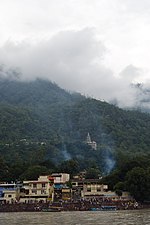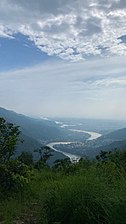Rishikesh, also spelt as Hrishikesh, is a city near Dehradun in Dehradun district of the Indian state Uttarakhand. It is situated on the right bank of the Ganges River and is a pilgrimage town for Hindus, with ancient sages and saints meditating here in search of higher knowledge. There are numerous temples and ashrams built along the banks of the river.
It is known as the “Gateway to the Garhwal Himalayas” and “Yoga Capital of the World“. The city has hosted the annual “International Yoga Festival” on the first week of March since 1999. Rishikesh is a vegetarian-only and alcohol-free city.
The Tehri Dam is just 86 km (53 mi) away and Uttarkashi, a popular yoga destination, is 170 km (110 mi) uphill on the way to Gangotri. Rishikesh is the starting point for travelling to the four Chota Char Dham pilgrimage places: Badrinath, Kedarnath, Gangotri, and Yamunotri. It’s also a starting point for the Himalayan tourist destinations such as Harsil, Chopta, Auli and famous summer and winter trekking destinations like Dodital, Dayara Bugyal, Kedarkantha, Har Ki Dun for camping and grandeur Himalayan panoramic views.
In September 2015, the Indian Minister of Tourism Mahesh Sharma announced that Rishikesh and Haridwar would be the first “twin national heritage cities”.As of 2021, Rishikesh has a total population of 322,825 with the tehsil including the city and its 93 surrounding villages.
The city is governed by Rishikesh Municipal Corporation and tehsil.
Etymology
IAST: “Hṛṣīkeśa” (Sanskrit: हृषीकेश) is a name derived from Vishnu, composed of hṛṣīka meaning ‘senses’ and īśa meaning ‘lord’ for a combined meaning as ‘Lord of the Senses’. The name commemorates an apparition of Vishnu to Raibhya Rishi, as a result of his tapasya (austerities), as Lord Hrishikesha. In the Skanda Purana, this area is known as Kubjāmraka (कुब्जाम्रक), as Lord Vishnu appeared under a mango tree.
History
Rishikesh was part of the legendary “Kedarkhand” mentioned in the Skanda Purana. Legends state that Lord Rama did penance here for killing Ravana, the asura king of Lanka. Lakshmana, Rama’s younger brother, crossed the Ganges using two jute ropes at the point where the present Lakshman Jhula (लक्ष्मण झूला) suspension bridge stands today. The 248-foot long iron-rope suspension bridge built in 1889 was washed away by flooding in 1924. In 1927, it was replaced by the current, stronger bridge built by the United Provinces Public Works Department, connecting the Tapovan, Tehri and Jonk, Pauri Garhwal districts. Anoted suspension bridge named Ram Jhula was built in 1986 at the nearby Sivananda Nagar. The Skanda Purana also mentions the site as “Indrakund” where Indra underwent a holy bath to remove a curse.
The Gazeteer of Dehradun, written by Indian Civil Service officer HG Walton, describes the site as “beautifully situated on the right bank of the Ganges, on a high cliff overlooking the river. The place is developing very rapidly, especially since the construction of the new bridge over the Song river, the realignment of the pilgrim road from Raiwala to Rishikesh.”
The Ganges, one of the most sacred rivers to Hindus, flows through Rishikesh in its course from the Shivalik Hills of the Himalayas to the plains of northern India with temples built along the banks Shatrughna Mandir, Bharat Mandir, and Lakshman Mandir are the ancient temples established by Adi Shankaracharya. Shatrughna Temple is near the Ram Jhula suspension bridge, while Lakshman Mandir is situated near Lakshman Jhula suspension bridge.
The historical records mention that some pilgrims used to stay at Rishikesh, either seeking the site itself or using it as a resting place before moving onwards to the Himalayas. In the transition to a modern tourist town, local markets have evolved from commercializing goods such as local and religious handicrafts to a service-oriented tourist industry with provision stores, cafes, hotels, sites for rafting, and centers for yoga and meditation.
Geography

A view of temples on the banks of river Ganges near Laxman Jhula
Rishikesh is at 30.103368°N 78.294754°E. It has an average elevation of 340 metres (1,120 ft). The town is located in the Tehri Garhwal region of the northern Indian state of Uttarakhand.
After flowing 249 km (155.343 mi) through narrow Himalayan valleys, the Ganges emerges at Rishikesh before debouching onto the Gangetic Plain at the pilgrimage town of Haridwar. Despite the pollution of the Ganges, the water in Rishikesh is relatively unaffected, as the major polluting points are down river in the neighbouring state of Uttar Pradesh.
According to the Köppen-Geiger climate classification system, its climate is humid subtropical (Cwa). The average maximum temperature is 40°C (104°F). The average minimum temperature is 7°C. The wettest month is July with highest rainfall of 444 mm. The driest month is November with rainfall of 10 mm. Months of May, June, July and August has the highest UV index of 12 and January and December have the lowest UV index of 4.
| hideClimate data for Rishikesh | |||||||||||||
|---|---|---|---|---|---|---|---|---|---|---|---|---|---|
| Month | Jan | Feb | Mar | Apr | May | Jun | Jul | Aug | Sep | Oct | Nov | Dec | Year |
| Average high °C (°F) | 17 (63) |
22 (72) |
29 (84) |
35 (95) |
39 (102) |
38 (100) |
33 (91) |
32 (90) |
32 (90) |
30 (86) |
25 (77) |
20 (68) |
29 (85) |
| Average low °C (°F) | 5 (41) |
8 (46) |
14 (57) |
18 (64) |
23 (73) |
25 (77) |
25 (77) |
24 (75) |
23 (73) |
15 (59) |
9 (48) |
6 (43) |
16 (61) |
| Average precipitation mm (inches) | 51 (2.0) |
33 (1.3) |
34 (1.3) |
9 (0.4) |
20 (0.8) |
94 (3.7) |
482 (19.0) |
495 (19.5) |
219 (8.6) |
76 (3.0) |
9 (0.4) |
17 (0.7) |
1,539 (60.7) |
| Average rainy days | 3 | 2 | 3 | 1 | 2 | 7 | 15 | 16 | 8 | 2 | 0 | 1 | 60 |
| Mean daily sunshine hours | 6 | 7 | 8 | 9 | 9 | 7 | 6 | 6 | 7 | 8 | 8 | 7 | 7 |
| Source: Weather2Travel | |||||||||||||
Civic Administration
The Rishikesh Municipal Corporation has administered the city’s 40 wards since the 2018 incorporation of the urban local body. Each ward had between 2,300-3,000 residents during the 2018 assessment. Rishikesh belongs to the Haridwar Lok Sabha constituency. The first and the current mayor of the corporation is Anita Mamgain. The current Municipal Commissioner, commonly known as Nagar Aayukt locally, is Narendra Singh.
Demographics
As per provisional data of 2011 census, Rishikesh had a population of 102,138, out of which males were 54,466 (53%) and females were 47,672 (47%). The literacy rate was 86.86% compared to the national average of 74.04%.
Tourism
-

Tera Manzil Temple
-

Temple in Rishikesh
-

Ghats by the River Ganges
-

Ram Jhula Bridge across the Ganges at Muni Ki Reti, built in the 1980s
-

A Hanuman temple in Rishikesh
-

Rishikesh Views
-

Laxman Jhula bridge
-

View of Rishikesh
